Are you struggling to find Optavia healthy fats for your lean and green meals? You’re not alone.
For me, eating healthy fats has become a priority after my dad was diagnosed with type 2 diabetes.
I started to pay attention to what foods I can choose for my diet to stop diabetes before it starts, as it runs in my family.
The list below includes all healthy fats with recommended serving sizes, all approved by Optavia.

First, let’s talk about Optavia’s healthy fats
I’m sure you’ve heard that there are two types of fats – good fats and bad fats.
The good fats are the unsaturated fats (monounsaturated and polyunsaturated), which you get from plants and fish.
According to the article published in the Journal of the American College of Cardiology, “these types of fats can help to lower your cholesterol and improve your heart health.”
On the other hand, bad fats are the saturated and trans fats that you get from meat, dairy, and processed foods.
“Saturated fats can raise your cholesterol and increase your risk of heart disease,” states the journal.
Do you know which types of fats Optavia suggests we should eat?
According to Optavia’s healthy fat guidelines, you should be including mostly monounsaturated and polyunsaturated fats as these are considered to be more healthy than saturated fats.
And there is a reason for it.
These recommendations are in line with a recently published study in the Annals of Nutrition and Metabolism Journal, which states “the evidence that is available says that it is a good idea to replace saturated fats with monounsaturated and polyunsaturated fatty acids.”
The American Heart Association recommends choosing fats in the form of liquid non-tropical plant oils, low-fat or nonfat dairy, and, if you eat meat, lean meat or poultry.
Why is healthy fat important on Optavia?
Here’s a look at the benefits of healthy fats, according to research.
According to the Nutrition Reviews Journal:
“Diets that have a lot of saturated fatty acids and trans fatty acids can raise the LDL cholesterol levels. This raises the risk of heart disease.”
The Current Nutrition Reports Journal states that the “nutritional effects of polyunsaturated fatty acids can improve the physical functioning and metabolic rate of the body.
“They also help with various things in the cell, like cell signaling, the structure of the cell, and the regulation of blood pressure and glucose levels,” states the journal.
How many healthy fats can I have on Optavia Diet?
On the Optavia Diet, aim for a daily intake of 5-10 grams of fat. Your serving of healthy fats should contain between 50 to 100 calories, no more than 5 grams of fat, and fewer than 5 grams of carbohydrates.
Each day, you can have up to 2 servings of healthy fats in your lean and green meal, depending on your lean choices.
The lean choices, which are your approved meats and meatless options, are divided into three categories: lean, leaner, and leanest.
- Lean protein (5 oz serving size) – no additional healthy fat servings.
- Leaner protein (5 oz serving size) – 1 additional healthy fat serving.
- Leanest protein (7 oz serving size) – 2 additional healthy fat servings.
Optavia healthy fat guidelines
Here’s the graph that helps you to illustrate how to choose the number of servings of healthy fats in your lean and green meals.
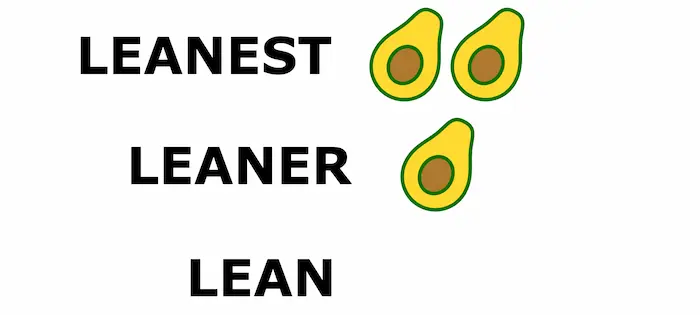
According to this graph:
- If you choose a lean protein food, such as salmon or red meat, then you cannot choose any healthy fats.
- If you choose a leaner protein option like ground turkey or pork chop, you can have one serving of healthy fat per meal.
- If you choose the leanest protein, such as egg whites or tofu, then you can have up to two healthy fats per meal.
The difference is that lean options include meats that are already higher in fats, so you don’t need more.
The leanest meats have the least amount of fat, so you can add more fats, ideally from Optavia’s healthy fats list below.
On top of the 2 servings of healthy fats, I also use 3 servings of condiments per day from the Optavia-approved condiment list.
Although I mostly use dried herbs and spices, I also like to include calorie-free salad dressings that also have healthy fats.
Okay, I got it! – Show me the Optavia healthy fats list
If one of my closest friends asked me what are the best choices of healthy fats she could eat on the Optavia diet food list, these would be my suggestions.
Each food item below has a name and a recommended serving size that equals 1 healthy fat, according to the healthy fat guidelines from Optavia.
Avocado – 1 ½ oz
You can eat avocados on Optavia, but you need to limit your serving size to 1 1/2 tablespoons.
I buy avocados on weekly basis not only becasue its healthy, but they also taste great and it keeps me fuller for longer.
Here’s a photo of avocados from my local grocery shop.
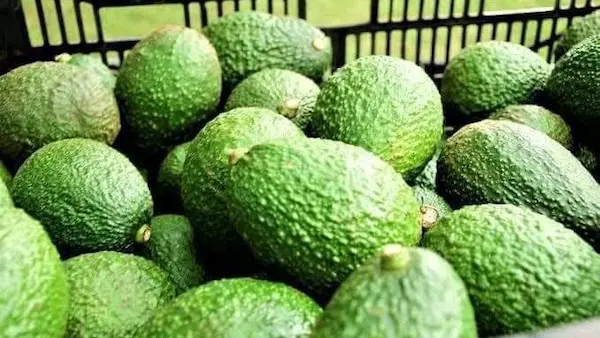
I like to choose avocados that are ripe (which makes them easier to chop and portion).
They should have darker skin and yield to pressure.
Another reason why we choose avocados in my home is becasue they are relatively low in calories. Two slices of avocado (30 grams) contain just 48 calories and 4.4 grams of fat (1).
(That makes it a great choice for people watching their weight.)
Avocados are also a good source of fiber and vitamins C, E, and K.
And unlike other sources of fat, avocados contain mostly monounsaturated fat, which is the “good” kind of fat that can help to lower cholesterol levels (2).
Olives – 10 pieces
Although olives are one of my favorite Optavia low-calorie snacks, I often add them as my healthy fat to lean and green meals.
I like to choose young green olives that have dense and firm flesh. (Always with the seeds.)

I found that green olives with a pit have a stronger, somewhat bitter flavor. I don’t buy olives stuffed with pimento, nuts, or other foods.
Olives are also a good source of monounsaturated fats, which can help to lower cholesterol levels and reduce the risk of heart disease (3).
As for serving size,
If I choose olives as my healthy fat option for Optavia, I go for 10 pieces, which have 58 calories and 6 grams of fat (4).
Dark chocolate – 2 pieces

Dark chocolate is not only full of healthy fats, but it also contains vitamins A, B, and E. It also has calcium, potassium, iron, and plant-based antioxidants called flavonoids.
I like to buy dark chocolate that has at least 70 percent cacao. (Anything less than 70 percent tastes too sweet and makes me want to eat more.)
On the contrary, eating just 1-2 pieces of 80-90 percent cocoa dark chocolate is enough to kill my cravings for sweets.
Olive oil – 1 tbsp
Olive oil is often praised as a healthy fat, and for good reason.
According to the European Journal of Clinical Nutrition, “extra virgin olive oil may help reduce cardiovascular risk factors like inflammation, oxidative stress, coagulation, platelet aggregation, fibrinolysis, endothelial function or lipids.”
Although it is high in calories, olive oil is packed with beneficial nutrients. One tablespoon (14 grams) has 126 calories and 14 grams of fats (5).
(So use it with moderation and be mindful of servings size.)
Here’s a photo of my favorite virgin olive oil I buy in Walmart.

I also like to choose extra virgin olive oil becasue it’s unrefined, and it has less oleic acid than regular olive oil.
(However, it’s also almost twice more expensive.)
Almonds – 1⁄3 oz (8 pieces)
You can have almonds as a snack, but for me, I like to have them as a healthy fat with my lean and green meals.
I like to choose raw whole almonds as it makes it easier to portion them by serving size.
Here’s what my almond serving size looks like – equivalent to 2 healthy fats.
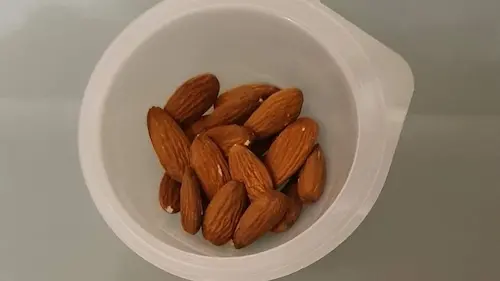
Here you see around 18 almonds, which have a total of 140 calories and 12 grams of fat (6).
If you’re following the healthy exchange food list from the Optimal Health 3 and 3 plan, you can have 12 almonds per serving.
Sure, almonds have a lot of calories, but they are a good source of monounsaturated fat.
According to the Journal of the American Nutrition Association, “people who ate raw almonds experienced a rapid and sustained reduction in low-density lipoprotein cholesterol without changes in high-density lipoprotein cholesterol.”
Cashews – 1⁄3 oz (8 pieces)
Although cashews are a little bit sweeter than almonds, they balance perfectly well with some of my favorite Optavia chicken recipes.
Additionally, cashews are a good source of protein and fiber, which helps to keep me feeling energized throughout the day.
I like cashews because they are lower in calories than other types of nuts. A serving size is about 8 pieces, which has around 64 calories and 5 grams of fat (7).
Here’s a photo of how I like to eat my cashews.
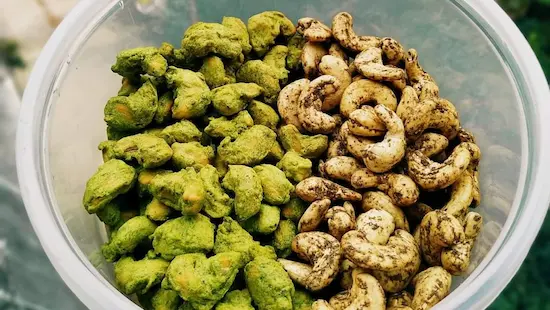
In this plastic container, half of the cashews are roasted, and half coated with wasabi.
(My wife likes to buy plain cashews and experiment with different flavors.)
Peanuts – 1⁄3 oz (12 pieces)
You might not think of peanuts as a healthy food, but they actually contain a type of fat that can be good for you.
Peanuts are relatively high in calories, but they’re a good source of monounsaturated fat and provide a good amount of protein and fiber.
When buying peanuts, I look for those that are dry-roasted or raw.
Here’s a photo of my favorite raw peanuts.
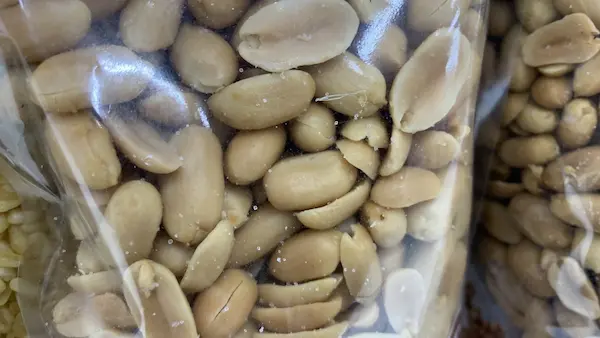
Be sure to check the serving size – a small handful of peanuts (about 12 pieces) is all you need to get 1 serving of Optavia healthy fat.
This equals to around 60 calories, and 4.5 grams of fat (8).
I like to add a few peanuts to my lean and green salads for a little extra crunch.
Pesto – 1 tbsp
If you’re looking for healthy fat to add to your Optavia diet, pesto is a great option.
When I have more time, I like to make homemade pesto from olive oil, garlic, basil, and Parmesan cheese.
When I don’t have time, I usually buy it from my local Walmart.
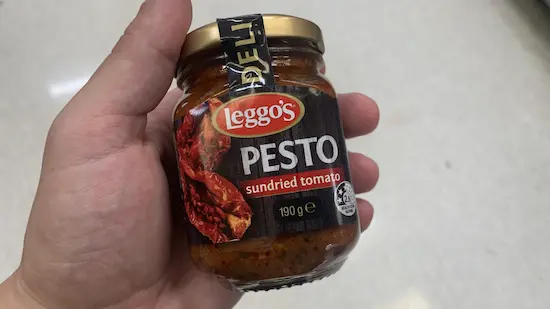
The one in the picture is a red pesto, made from sundried tomatoes, olive oil, and garlic.
Just one tablespoon of pesto (16 grams) is enough for one serving. It contains about 90 calories and 9 grams of fat (9).
Mayonnaise (light) – 1 ½ tbsp
Despite what you may have heard, mayonnaise is actually a healthy fat. It’s usually made by blending of oil, vinegar, egg yolk, and spices, so it’s packed with healthy unsaturated fats.
According to the randomized controlled trial published in the Journal of Nutritional Science and Vitaminology, “adding mayo to a salad can help your body to absorb more carotenoids, which are important antioxidants.”
Although I’m not a big fan of mayonnaise, it is listed on the Optavia-approved healthy fats list. If you choose to use mayonnaise, go for a lighter version.
Here’s my favorite light mayonnaise from Hellmann’s.
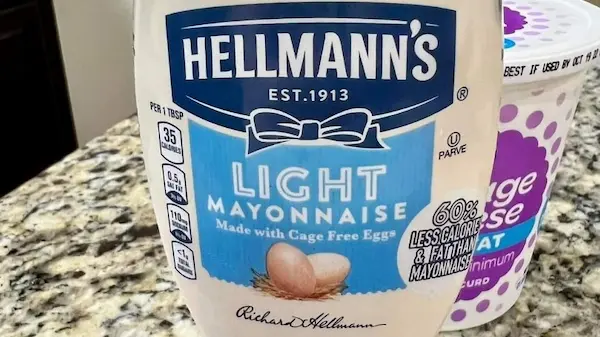
This one has only 37 calories and 3 grams of fat per tablespoon (10), which is enough for one serving.
Walnuts – 1⁄3 oz (5 halves)
Although I prefer to buy walnuts without shells as they can stay in my pantry for up to 12 months, my wife says she prefers the taste of shelled walnuts.
In my home, she uses walnuts not only for lean and green meals, but also for cakes, desserts, and other baked goods.
Here’s what our serving size for walnuts as a healthy fat looks like.

Walnuts are a good source of omega-3 fatty acids, which have been shown to have numerous health benefits.
A study published in the Nursing Standard Journal states that “omega 3 fatty acids have been shown to improve heart health, reduce inflammation, and even help to prevent cancer.”
If you want t choose walnuts as your healthy fat option, one serving size is around 5 full halves – an equivalent to 65 calories and 6 grams of fats (11).
Pumpkin seeds – 2 tbsp
Here’s a photo of our bag of pumpkin seeds – we always buy them in bulk becasue it can stay longer in our pantry.
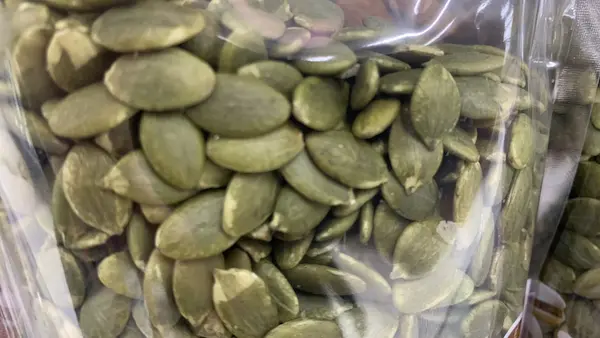
Pumpkin seeds are a healthy fat, are low in calories, and contain nutrients that are essential for good health.
They are an excellent source of antioxidants, minerals, and vitamins, and they have been shown to improve heart health, reduce inflammation, and boost immunity.
If you choose them as Optavia healthy fat, one serving (1 tablespoon) has 14 calories (12).
I like to add pumpkin seeds to salads or eat them as a snack. What I don’t like is that they can be a little hard to digest.
Sunflower seeds (kernel only) – 1 tbsp
Another Optavia-approved healthy fat that is high on my personal list is sunflower seeds. They add a nice kick and flavor to otherwise bland foods.
Just like pumpkin seeds, I often buy them in bulk for easy storage. I choose shelled seeds becasue
When we buy sunflower seeds, I ensure they come in shells.

(I find that when I spit out the shells, I tend to eat less than if I would snack on them unshelled.)
I use them for healthy fats in my lean and green meals, as well as a mid-morning snacks.
I often add sunflower seeds to my cottage cheese and on top of my salads, as well as to my homemade Optavia fuelings.
For my lean and green meals, I measure one tablespoon (10 grams) as one healthy fat serving, which has around 50 calories (13).
Coconut (shredded, unsweetened) – 1 ½ tbsp
Here’s the photo of the coconut I like to buy in my local store.

I love the taste and texture of fresh coconut, but with 283 calories per 80 grams, I must be very careful (14).
That’s why we only use shredders coconut for a variety of baked goods, homemade protein bars, and Optavia pudding hacks.
Cream cheese (regular) – 1 tbsp
Cheese can also be a healthy fat option on Optavia.
Here’s a photo of my favorite cream cheese – laughing cow light.
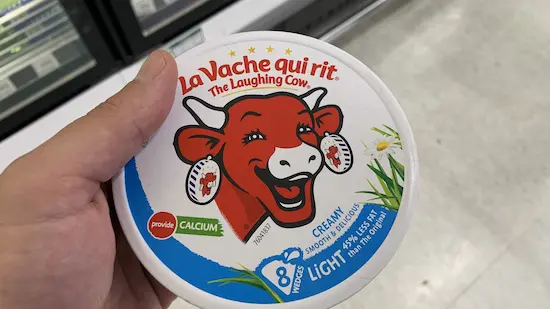
I use laughing cow cheese as a condiment, as well as a healthy fat on Optavia.
I really like cream cheese because it’s low in calories and it tastes great. I usually spread it on meats, fish, or veggies, but it’s also good in other recipes.
I like that I can have a lot of cream cheese without having to worry about calories, and it’s also a good source of protein.
One tablespoon (15 grams) of cream cheese light equals to one Optavia healthy fat serving. It has around 30 calories and 2 grams of fats (15).
Sour cream – 2 tbsp
I always have low-fat sour cream in my fridge. I love how versatile it is. I can add it to meats, soups, and salads for extra flavor.

And, because it’s low in calories, I don’t have to feel guilty about using it liberally.
Two tablespoons (30 grams) of sour cream light equal to one Optavia healthy fat serving. It has less than 40 calories and only 3 grams of fats (16).
Plus, it just tastes good! Whether I’m eating a lean and green meal, or something that’s a little more indulgent, sour cream makes it better.
Optavia healthy fat chart
The list below includes some of my favorite healthy fat choices, like avocados and nuts, as well as some less familiar options, like chia seeds and hemp hearts.
It is divided into categories, so you can easily find the fats that best meet your needs.
It includes the name of the food item, as well as recommended quantity equal to 1 healthy fat serving size.
The list is divided into:
- Monounsaturated
- Polyunsaturated
- Saturated
Optavia monounsaturated healthy fats list
- Almond flour: 1 ½ Tbsp
- Avocado: 1 ½ oz
- Guacamole: 2 Tbsp
- Olives: 5 – 10 black or green olives
Milk
- Almond (refrigerated, unsweetened original or unsweetened vanilla): 2 cups
- Cashew (refrigerated, unsweetened original or unsweetened vanilla): 2 cups
Oils
- Avocado: 1 tsp
- Canola: 1 tsp
- Olive: 1 tsp
- Peanut: 1 tsp
Nuts
- Almonds: 1⁄3 oz (~8 pieces)
- Pesto: 1 Tbsp
Seeds
- Sesame Seeds: 1 Tbsp
Optavia polyunsaturated healthy fats list
- Margarine (regular): ½ Tbsp
- Margarine (reduced-fat): 1 Tbsp
- Mayonnaise (regular): ½ Tbsp
- Mayonnaise (light): 1 ½ Tbsp
- Mayonnaise (reduced-fat with olive oil): 1 Tbsp
Nuts
- Pine: 1⁄3 oz (~55 kernels)
Oil
- Flaxseed: 1 tsp
- Grapeseed: 1 tsp
- Safflower: 1 tsp
- Sesame: 1 tsp
- Soybean: 1 tsp
Seeds
- Chia: 1 Tbsp
- Flax (ground): 2 Tbsp
- Flax (whole): 1 Tbsp
- Hemp: 1 Tbsp
- Poppy: 1 Tbsp
- Pumpkin: 1 Tbsp
- Sunflower (kernel only): 1 Tbsp
Optavia saturated healthy fats list
- Butter: ½ Tbsp
- Coconut (shredded, unsweetened): 1 ½ Tbsp
- Cream (half & half): 3 Tbsp
- Cream cheese (regular): 1 Tbsp
- Cream cheese (low-fat): 2 Tbsp
Milk
- Coconut (canned, regular): 2 Tbsp
- Coconut (canned, light): ¼ cup
- Coconut (refrigerated, unsweetened original or unsweetened vanilla): 1 cup
- Sour cream: 2 Tbsp
- The Laughing Cow Spreadable Cheese Original Swiss: 1 wedge
Other Optavia healthy fats you can use
- Canned tuna: 1 regular can (5 grams fat)
- Tofu: 3 oz (4 grams fat)
- Edamame: ½ cup, shelled (4,5 grams fat)
- Egg: 1 medium whole egg (5 grams fat)
- Anchovies: 2 oz can (4,5 grams fat)
- Sardines: ½ can (3,75 oz) (4 grams fat)
- Cheddar Cheese: ½ oz (4,5 grams fat)
What fats should you avoid on Optavia?
There are certain types of fats that didn’t meet the requirements for “healthy fats” in the Optavia 5 and 1 plan.
Peanut butter
Although peanut butter is a nutritious and versatile snack, I would avoid using it on Optavia 5 and 1 plan.
One tablespoon has 95 calories and 8 grams of fats (17), which is almost double what other fats contain.
According to a study of many clinical trials published in the Frontiers in Nutrition Journal, “people who eat peanuts have fewer triglycerides. However, people who were already at high risk for heart problems gained weight after eating peanut butter.”
Therefore, eating too much peanut butter can hinder your weight loss goals.
Honey
You should not eat honey on Optavia, at least during the weight loss phase. Honey is high in calories and sugar, without providing many essential nutrients.
Additionally, it contains fructose which is a simple sugar that can lead to weight gain and other health problems when consumed in large amounts.
Instead of using honey, consider adding some of the approved Optavia sweeteners that have zero calories and zero sugar.
Trans fats
Trans fats are the ones that should be avoided. Any food label that includes the words “partially hydrogenated oils” contains trans fat.
According to the Journal of Food Science and Technology, “people who consume too much trans fat put themselves at risk for stroke, heart attack, and diabetes.”
Additionally, heart experts recommend that people generally avoid saturated fats as they are known to increase levels of LDL cholesterol in the blood.
High levels of LDL cholesterol increase your risk for stroke and heart disease, which is why the American Heart Association recommends limiting one’s daily saturated fat consumption to between 5-6% of total caloric intake.
Can You Have Laughing Cow Cheese On Optavia?
Yes, you can have Laughing Cow cheese on Optavia. However, it is recommended to use Laughing Cow cheese as a condiment or a healthy fat serving. One tablespoon (15 grams) of Laughing Cow cream cheese light is considered equivalent to one Optavia healthy fat serving. It contains approximately 30 calories and 2 grams of fat.
Reference
U.S. Department of Agriculture, Agricultural Research Service. FoodData Central, 2019. fdc.nal.usda.gov.
2. Dreher, Mark L, and Adrienne J Davenport. “Hass avocado composition and potential health effects.” Critical reviews in food science and nutrition vol. 53,7 (2013): 738-50. doi:10.1080/10408398.2011.556759
3. Gillingham, Leah G et al. “Dietary monounsaturated fatty acids are protective against metabolic syndrome and cardiovascular disease risk factors.” Lipids vol. 46,3 (2011): 209-28. doi:10.1007/s11745-010-3524-y

